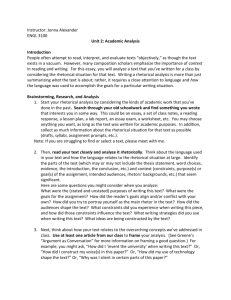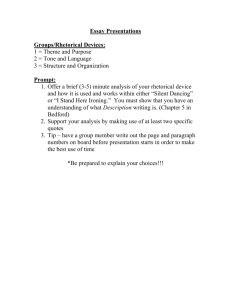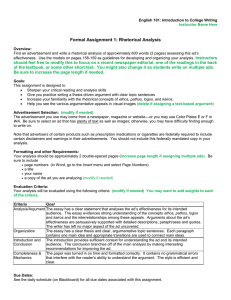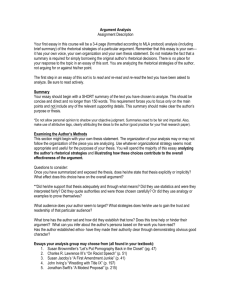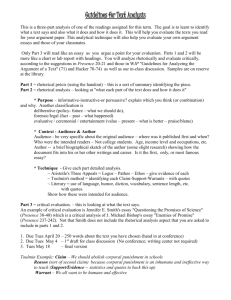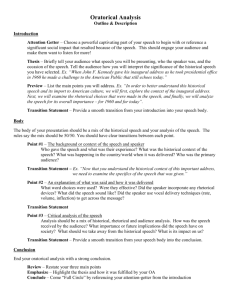The multiple-choice questions test your ability to read
advertisement
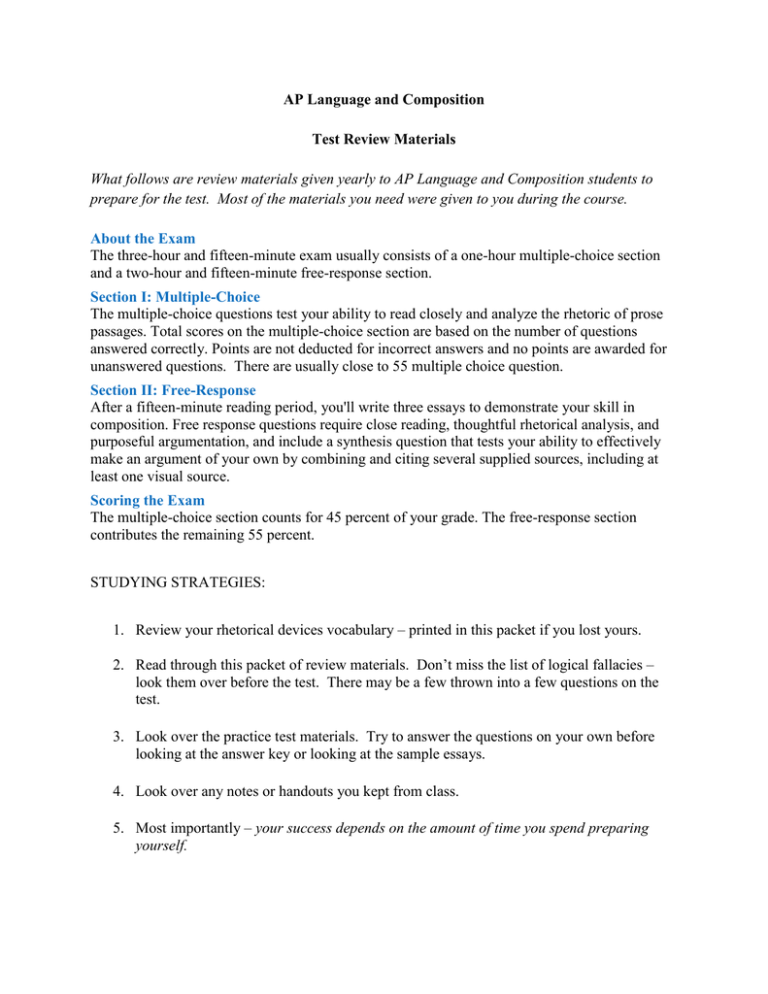
AP Language and Composition Test Review Materials What follows are review materials given yearly to AP Language and Composition students to prepare for the test. Most of the materials you need were given to you during the course. About the Exam The three-hour and fifteen-minute exam usually consists of a one-hour multiple-choice section and a two-hour and fifteen-minute free-response section. Section I: Multiple-Choice The multiple-choice questions test your ability to read closely and analyze the rhetoric of prose passages. Total scores on the multiple-choice section are based on the number of questions answered correctly. Points are not deducted for incorrect answers and no points are awarded for unanswered questions. There are usually close to 55 multiple choice question. Section II: Free-Response After a fifteen-minute reading period, you'll write three essays to demonstrate your skill in composition. Free response questions require close reading, thoughtful rhetorical analysis, and purposeful argumentation, and include a synthesis question that tests your ability to effectively make an argument of your own by combining and citing several supplied sources, including at least one visual source. Scoring the Exam The multiple-choice section counts for 45 percent of your grade. The free-response section contributes the remaining 55 percent. STUDYING STRATEGIES: 1. Review your rhetorical devices vocabulary – printed in this packet if you lost yours. 2. Read through this packet of review materials. Don’t miss the list of logical fallacies – look them over before the test. There may be a few thrown into a few questions on the test. 3. Look over the practice test materials. Try to answer the questions on your own before looking at the answer key or looking at the sample essays. 4. Look over any notes or handouts you kept from class. 5. Most importantly – your success depends on the amount of time you spend preparing yourself. TESTING STRATEGIES: 1. Be aware of the time. This is a timed test, so you don’t want to move too slowly. At the same time, do not rush so much that you miss the idea of what you are reading. 2. Read with purpose and focus: a close reading. Unlike the M.C.A.s, you don’t have time to read and reread. Stay focused during your first reading of a passage. 3. Annotate everything you read. As you read, mark up the passage with quick notes to help you focus on the important aspects, themes, shifts, and rhetorical strategies. 4. Unlike previous years, there is no penalty for guessing, so answer all questions. Leaving a question blank is marked wrong equally, so answer all. Watch your time and answer carefully. 5. Remember most AP multiple choice questions have more than one answer that will look right if you don’t think the question and the answer options through all the way. One answer is always more right than the others. 6. When writing your essays during part II of the test, try to divide your time fairly evenly. Allow yourself about 40 minutes to complete each essay. You are given an extra fifteen minutes to allow for a reading of the synthesis sources. 7. You don’t have to write the essays in order. Many have found the best strategy to be to complete the synthesis essay first. Complete the rhetorical analysis second. Complete the argument last because it is usually the easiest to complete. Decide what works best for you. a. After the synthesis essay, scan the other two essays and decide which essay will be more difficult. Tackle the more difficult of the two second. Leave the easiest one for last. That way if you are running out of time, you may have a better chance of finishing it. 8. Answer all essay questions. Leaving one blank can kill your test score. 9. Of course, write well – demonstrate your mastery of the English language. Don’t take shortcuts. 10. Remember the important rules of AP essay writing (following are a few): a. Avoid first and second person (I, me, we, you) unless it is called for in the prompt. b. Write a strong, clear thesis that answers the prompt completely – usually best to place the thesis at the end of the first paragraph or somewhere in the second. c. Don’t write in ALL CAPS!!! Synthesis Essay – key points: 1. Make sure you answer the prompt completely – complete the task assigned. 2. Make sure you use and cite at least three sources throughout your essay (unless you are told to cite more in the directions). 3. You may cite the source in the sentence itself or by placing a parenthetical reference at the end of the sentence before the end punctuation. Example: Our planet is not flat (Source B). 4. Make sure your argument is central in your writing. Use the sources to prove your points, not to replace your own words. There should be much more of your own ideas and words than there should be quoted material from the sources. a. Discuss an idea in your own words b. Introduce the content of your citation c. Cite the source d. Explain how that citation works into your argument. 5. Show complexity of thought. Think about all sides and show that you have thought about the complexity of the issue in your writing. (Remember the thoughtfulness paragraph.) Argument Essay – key points: 1. Make sure you answer the prompt completely – complete the task assigned. 2. Choose a side of the argument in your thesis. Don’t attempt to argue both sides equally – lean one way or the other. 3. Only use first person experience and language if the prompt asks you to do so. 4. Remember to discuss the complexity of the issue. Think about all sides and show your thoughtfulness. Concede something to the opposition, or at least write a paragraph showing an understanding of all sides of the issue (thoughtfulness paragraph). 5. Show your intelligence by using evidence and examples that prove your point. Explain your ideas thoroughly. 6. Remember, one basic strategy for writing an argument on the AP test that works is: a. Introduction paragraph i. Attention grabber related to the topic ii. Discuss the topic and its implications in the world. iii. State your position – your thesis – clearly defined and explained b. Thoughtfulness paragraph i. Demonstrate that you understand the complexity of the issue. You may even concede something to the opposition. c. Body i. Come back to your position and explain why you hold that position by presenting evidence that proves your ideas. (This is the meat of your essay – usually at least two or three paragraphs.) d. Conclusion i. Restate your thesis in a memorable way. Rhetorical Analysis – key points: SOME BASIC STRATEGIES FOR WRITING TIMED AP ANALYTICAL ESSAYS 1. The Prompt: To pass an AP essay, you MUST answer the prompt completely in the thesis of your essay. a. Read the prompt CAREFULLY and THOROUGHLY. b. Mark up the prompt, underlining or noting important words. 2. Reading the Text: You have a limited amount of time to read and analyze, so your first reading has to be a careful, close reading. a. Annotate as you read – mark up the text, noting anything you see the author doing with language to create meaning, tone, etc. Take brief notes about the main ideas of paragraphs. b. Always be sure you understand the author’s main idea in the writing. c. Always be sure you understand the author’s attitude toward the main idea. d. Always be sure you understand the author’s purpose in writing the text. e. Always be sure you understand the tone created by the author. f. Always be sure you understand how the author used language to express those ideas, indicate that attitude, present that purpose, create that tone. 3. Writing the Essay: Again, you have limited time, so you must get to work as soon as you have read the passage and figured out a complete answer to the prompt. ***Remember this is a graded first and only draft—it is graded with that understanding. Though neatness and clarity is important, editing marks are perfectly okay. a. Job number one: Come up with a thesis statement that answers the prompt COMPLETELY and intelligently. b. Write the first paragraph, the introductory paragraph. Find a way to grab the attention of the audience, and build toward your thesis statement. Think general theme and global connections first, then narrow the focus to your precise essay. i. If you are having a difficult time thinking of a clever or witty opening, jump to the basics of the thesis and get to work, don’t dwell on the opening for too long – you have limited time! If you come up with something later, add the opening in later – leave space for it, or draw an arrow. c. Use your thesis as a road map to plan the analytical body of your essay. d. Organize your ideas and develop those ideas into clear paragraphs with main ideas. e. Use direct references to the text itself to support your analysis. Show patterns that are clearly used by the author; give examples to prove those patterns. f. After each analytical observation with direct examples from the text, connect that analysis to the thesis. Explain how those observations connect to the author’s purpose, tone, or strategy. This part of each paragraph is key to a passing analysis. g. If you have time, write a concluding paragraph that sums up your essay, and states the main idea in a new and memorable way. College Board's A.P. Glossary of Rhetorical Terms 1. ad hominem argument—This term comes from the Latin phrase meaning “to the man.” It refers to an argument that attacks the opposing speaker or another person rather than addressing the issues at hand. (Example: It's easy for him to oppose the tax cut -- a millionaire with no children. What does he know about a need for cash?) 2. allegory—An allegory is a fictional work in which the characters represent ideas or concepts. In Paul Bunyan’s Pilgrim’s Progress for example, the characters named Faithful, Mercy, and Mr. Worldly Wiseman are clearly meant to represent types of people rather than to be characters in their own rights. 3. alliteration--The repetition of consonant sounds, usually at the beginning of words: the repeated “t” and “c” sounds in the sentence, “The tall tamarack trees shaded the cozy cabin,” are examples of alliteration. 4. allusion--A reference, usually oblique or faint, to another thing, idea, or person. For example, in the sentence, “She faced the challenge with Homeric courage,” “Homeric” is an allusion to Homer’s works The Illiad and The Odyssey. 5. ambiguity, ambiguous--When something is ambiguous, it is uncertain or indefinite; it is subject to more than one interpretation. For example, you might say, “The poet’s use of the word ‘love’ is ambiguous”, to begin to discuss the multiple meanings suggested by the use of the word and to indicate that there is an uncertainty of interpretation. 6. analogy--Analogy asks a reader to think about the correspondence or resemblance between two things that are essentially different. For example, if you say, “The pond was as smooth as a mirror,” you ask your audience to understand two different things--“pond” and “mirror”—as being similar in some fashion. 7. antecedent--Every pronoun refers back to a previous noun or pronoun—the antecedent; antecedent is the grammatical term for the noun of or pronoun from which another pronoun derives its meaning. For example: “The car he wanted to buy was a green one,” the pronoun “one” derives its meaning from the antecedent “car.” 8. antithesis--An opposition or contrast of ideas that is often expressed in balanced phrases or clauses. For example, “Whereas he was boisterous, I was reserved” is a sentence that balances two antithetical observations. 9. apostrophe--A figure of speech in which an absent person or personified object is addressed by a speaker. For example, “love” is personified and addressed as though present in the sentence, “Oh love, where have you gone?” 10. apotheosis--The word “apotheosis” is derived from the Greek word meaning to deify.” Apotheosis occurs in literature when a character or a thing is elevated to such a high status that it appears godlike. 11. appositive--A word or phrase that follows a noun or pronoun for emphasis or clarity. Appositives are usually set off by commas. For example, in the sentence, “The luxury train, The Orient Express, crosses Europe from Paris to Istanbul in just twenty-six hours,” the name “The Orient Express” is the appositive for “train.” 12. assonance--A type of internal rhyming in which vowel sounds are repeated. For instance, listen to the assonance caused by the repeated short "o" sounds in the phrase, "the pot's rocky, pocked surface." 13. asyndeton--Asyndeton occurs when the conjunctions (such as and or but) that would normally connect a string of words, phrases, or clauses are omitted from a sentence. For example, the sentence "I came, I saw, I conquered" employs asyndeton. 14. atmosphere--Atmosphere is the emotional feeling--or mood--of a place, scene, or event. In Toni Morrison's Beloved, for example, the opening chapters convey an atmosphere of loneliness and grief. 15. attitude--Attitude describes the feelings of a particular speaker or piece of writing toward a subject, person, or idea. This expression is often used as a synonym for tone. 16. bathos--Bathos is false or forced emotion that is often humorous. Whereas pathos draws upon deep emotion, bathos takes this emotion to such an extreme that the reader finds it humorous rather than touching. 17. contrast--Writers often use contrasts, or oppositions, to elaborate ideas. Contrasts help writers to expand on their ideas by allowing them to show both what a thing is and what it is not. Take, for instance, images of light and darkness: a reader may better appreciate what it means to have light by considering its absence--darkness. 18. diction--Diction refers to an author's choice of words. For instance, in the sentence, "That guy was really mad!" the author uses informal diction ("guy," "mad"), whereas in the sentence, "The gentleman was considerably irritated," the author uses more elevated diction ("gentleman," "irritated"). A writer's diction contributes to the tone of a text. 19. elegaic, elegy--An elegy is a work (of music, literature, dance, or art) that expresses sorrow. It mourns the loss of something, such as the death of a loved one. 20. ethos--Ethos is the characteristic spirit or ideal that informs a work. In The Country of the Pointed Firs by Sarah Orne Jewett, for instance, the ethos of the work is derived from the qualities of the inhabitants, who are described as both noble and caring. Ethos also refers more generally to ethics, or values. In rhetorical writing, authors often attempt to persuade readers by appealing to their sense of ethos, or ethical principles. 21. euphemism--A euphemism is a mild or pleasant sounding expression that substitutes for a harsh, indelicate, or simply less pleasant idea. Euphemisms are often used to soften the impact of what is being discussed. For example, the word "departed" is a euphemism for the word "dead," just as the phrase "in the family way" is a euphemism for the word "pregnant." 22. exposition--The word "exposition" refers to writing or speech that is organized to explain. For example, if the novel you read involves a wedding, your exposition might explain the significance of the wedding to the overall work of literature. 23. fiction--The word "fiction" comes from the Latin word meaning to invent, to form, to imagine. Works of fiction can be based on actual occurrences, but their status as fiction means that something has been imagined or invented in the telling of the occurrence. 24. figurative language--Figurative language is an umbrella term for all uses of language that imply an imaginative comparison. For example, "you've earned your wings" is a figurative way to say, "you've succeeded;" it implies a comparison with a bird who has just learned to fly. Similes, metaphors, and symbols are all examples of figurative language. 25. foreshadowing--Foreshadowing is a purposeful hint placed in a work of literature to suggest what may occur later in the narrative. For instance, a seemingly unrelated scene in a mystery story that focuses on a special interest of the detective may actually foreshadow the detective's use of that expertise in solving the mystery. 26. hyperbole--Hyperbole is a figure of speech in which exaggeration is used to achieve emphasis. The expressions, "my feet are as cold as an iceberg" and "I'll die if I don't see you soon," are examples of hyperbole. The emphasis is on exaggeration rather than literal representation. Hyperbole is the opposite of understatement. 27. image, imagery--An image is a mental picture that is conjured by specific words and associations, but there can be auditory and sensory components to imagery as well. Nearly all writing depends on imagery to be effective and interesting. Metaphors, similes, symbols, and personification all use imagery. 28. irony, ironic--Irony occurs when a situation produces an outcome that is the opposite of what is expected. In Robert Frost's poem "Mending Fences," for instance, it is ironic that the presence of a barrier--a fence--keeps a friendship alive; Frost's observation that "Good fences make good neighbors" is both true and ironic. Similarly, when an author uses words or phrases that are in opposition to each other to describe a person or an idea, an ironic tone results. For example, in The Yellow Wallpaper by Charlotte Perkins Gilman, when the speaker says that "I am glad my case is not serious!" the reader--who is also aware just how "serious" her case is--is aware of the irony of the statement. 29. juxtaposition--When two contrasting things--ideas, words, or sentence elements--are placed next to each other for comparison, a juxtaposition occurs. For instance, a writer may choose to juxtapose the coldness of one room with the warmth of another, or one person's honesty with another's duplicity. Juxtaposition sheds light on both elements in the comparison. 30. logos--The word "logos" refers to the use of reason as a controlling principle in an argument. In rhetorical writing, authors often attempt to persuade readers by appealing to their sense of logos, or reason. 31. metaphor--A metaphor is a figure of speech in which two unlike things are compared directly, usually for emphasis or dramatic effect. For instance, the observation that "she lived a thorny life" relies on an understanding of how dangerous and prickly thorns can be. In an extended metaphor, the properties of a single comparison are used throughout a poem or prose work. For example, if you call government "the ship of state," you could extend the metaphor by calling industry and business the "engines" of this ship, and by calling the citizens of the state "passengers" of the ship. 32. metonymy--Metonymy is a figure of speech in which something is referred to by using the name of something that is associated with it. For example, a crown is associated with royalty, and is often used as a metonym for royal authority ("The edict issued today by the Crown forbids grazing in the commons."). 33. mood--Mood is the prevailing or dominant feeling of a work, scene, or event. The opening scene of Macbeth in which three witches are center stage, for instance, sets a mood of doom and tragedy for the first act of the play. Mood is similar to atmosphere. 34. onomatopoeia--Onomatopoeia is an effect created by words that have sounds that reinforce their meaning. For example, in the sentence, "The tires screeched as the car zoomed around the corner," the words "screeched" and "zoomed" are onomatopoetic because the sounds they make when spoken are similar to the sounds the car makes when performing these actions. 35. oxymoron--An oxymoron combines two contradictory words in one expression. The results of this combination are often unusual or thought provoking. For instance, if you praise a child for her "wild docility," in essence you change the separate meanings of the words "wild" and "docility" and create a new, hybrid image. 36. pacing, or narrative pacing--Pacing is the speed of a story's action, dialogue, or narration. Some stories are told slowly, some more quickly. Events happen fast or are dragged out according to the narrator's purpose. For example, "action movies" are usually fast paced; when their pacing slows, the audience knows that the section is being given special emphasis. 37. paradox--A paradox is a seeming contradiction that in fact reveals some truth. For example, the paradoxical expression, "he lifted himself up by his bootstraps," suggests a physical impossibility, and thus communicates a truth about the enormity of the person's achievement. 38. parallelism--Parallelism is a literary technique that relies on the use of the same syntactical structures, (phrases, clauses, sentences) in a series in order to develop an argument or emphasize an idea. For example, in the declaration, "At sea, on land, in the air, we will be loyal to the very end," the parallel phrases at the beginning of the sentence emphasize the loyalty and determination of a group of people. 39. parody--Parody is an effort to ridicule or make fun of a literary work or an author by writing an imitation of the work or of the author's style. 40. pathos--Pathos is a sympathetic feeling of pity or compassion evoked by an artistic work. In rhetorical writing, authors often attempt to persuade readers by appealing to their sense of pathos, or their emotions. 41. person--Person is a grammatical term that describes the relationship of a writer or speaker to an audience by examining the pronouns that are used. Depending on the choice of pronouns, narration is said to be written in first person (I, we), second person (you, both singular and plural), or third person (he, she, it, they). 42. persona--Persona is the character created by the voice and narration of the speaker of a text. The term "persona" implies a fictional representation or an act of disguise (that the speaker is not the author, but a created character). 43. personification--Personification is a figure of speech in which ideas or objects are described as having human qualities or personalities. For example, in the sentence, "The saddened birch trees were bent to the ground, laden with ice; they groaned and shivered in the cold winds," the trees are personified, or represented as capable of human emotion. 44. point of view--The particular perspective from which a story is told is called the point of view. Stories may be told from the point of view of specific characters or a narrator. The narrator, in turn, may be a subjective narrator (who may or may not be involved in the story), or an all-knowing (omniscient) narrator. (An omniscient narrator can tell you everything about the characters--even their inner feelings and thoughts.) Examining the person of the pronouns used can further describe point of view. Some literary works blend different point of view for emphasis and experimentation. 45. pun--A pun is a play on words. A pun is created by using a word that has two different meanings, or using two different words with similar meanings, for a playful effect. Shakespeare uses puns extensively in his plays; in Hamlet, for instance, Hamlet says he is "too much in the sun," making use of the meaning of the word "sun" and stressing his role as a "son" simultaneously. 46. repetition--Repetition is the reiteration of a word or phrase for emphasis. 47. rhetoric, rhetorical purpose--Rhetoric is the art and logic of a written or spoken argument. Rhetorical writing is purposeful; examples of rhetorical purposes include to persuade, to analyze, or to expose. The lines between purposes, strategies, and devices are blurry. To accomplish a rhetorical purpose, a writer develops a rhetorical strategy, and then uses rhetorical devices to accomplish the goal. Consider shelter as an example. If your purpose in constructing a shelter is to protect you from inclement weather, one strategy for doing this might be to build a house (other strategies might involve a tent or a cave, for instance). Devices would be the choices that you make as you build the house, such as whether to use wood or bricks, the number and location of doors and windows, and so on. In the same way, to achieve a purpose in writing you need a strategy and devices. To use a more literary example, when arguing to persuade the world that Americans deserved to be independent from England (rhetorical purpose), the writers of the Declaration of Independence refused to recognize Great Britain's legislative authority (rhetorical strategy). To achieve this in their prose, the writers used syntax (rhetorical device) that presented all Americans as adhering to one idea ("We the People ... ") and diction (rhetorical device) that affirmed their right to be independent ("self-evident" and "endowed by their Creator"). 48. rhetorical question--A rhetorical question is a question that is asked for the sake of argument. No direct answer is provided to a rhetorical question; however, the probable answer to such a question is usually implied in the argument. 49. rhetorical, or narrative, strategy--A strategy is a plan of action or movement to achieve a goal. In rhetoric or writing, strategy describes the way an author organizes words, sentences, and overall argument in order to achieve a particular purpose. 50. satire--To satirize is to ridicule or mock ideas, persons, events, or doctrines, or to make fun of human foibles or weaknesses. "A Modest Proposal" and Gulliver's Travels, both by Jonathan Swift, are satires of particular people and events of his time. 51. selection of detail--The specific words, incidents, images, or events the author uses to create a scene or narrative are referred to as the selection of detail. 52. simile--A simile is a commonly used figure of speech that compares one thing with another using the words "like" or "as." For example, the sentence, "He drank like a camel, he was so thirsty," contains the simile "like a camel." 53. speaker--The speaker is the narrator of a story, poem, or drama. The speaker should not be confused with the author, who creates the voice of the speaker; the speaker is a fictional persona. 54. syllogism--A syllogism is a form of deductive reasoning in which pieces of evidence are used to create a new conclusion. For instance, the sentence, "All children are imaginative; Sam is a child; therefore Sam is imaginative," employs deductive reasoning and is a syllogism. 55. symbol--A symbol is something that stands for something else. The American flag, for instance, is a symbol of the United States. Literary symbols often refer to or stand for a complex set of ideas; the moors in Wuthering Heights, for instance, symbolize the wild and complex relationship of Catherine and Heathcliff. 56. synonym--A word that has the same, or nearly the same, meaning as another word is called a synonym. For example, funny is a synonym for laughable; big for large; secret for hidden; silly for ridiculous. 57. syntax--Syntax refers to the way words are arranged in a sentence. For example, the following two sentences share a similar meaning, but have different syntax, or word order: "The big blue sky beckoned her" essentially says the same thing as "She was beckoned by the big blue sky." 58. tension--Tension, in a work of literature, is a feeling of excitement and expectation the reader or audience feels because of the conflict, mood, or atmosphere of the work. 59. texture--Texture describes the way the elements of a work of prose or poetry are joined together. It suggests an association with the style of the author--whether, for instance, the author's prose is rough-hewn (elements at odds with one another) or smooth and graceful (elements flow together naturally). 60. theme--The theme of a work is usually considered the central idea. There can be several themes in a single work. In The Woman Warrior, for instance, Maxine Hong Kingston includes endurance, loyalty, bravery, intelligence, fortune, and risk as themes variously treated and dramatized. 61. tone--Tone, which can also be called attitude, is the way the author presents a subject. An author's tone can be serious, scholarly, humorous, mournful, or ironic, just to name a few examples. A correct perception of the author's tone is essential to understanding a particular literary work; misreading an ironic tone as a serious one, for instance, could lead you to miss the humor in a description or situation. 62. understatement--When an author assigns less significance to an event or thing than it deserves, the result is an understatement. For example, if a writer refers to a very destructive monsoon as "a bit of wind," the power of the event is being deliberately understated. 63. voice--How the speaker of a literary work presents himself or herself to the reader determines that speaker's unique voice. For example, the speaker's voice can be loud or soft, personal or cold, strident or gentle, authoritative or hesitant, or can have any manner or combination of characteristics. Voice is also a grammatical term. A sentence can be written in either active or passive voice. A simple way to tell the difference is to remember that when the subject performs the action in the sentence, the voice is active (for example, "I sent the letter"); when the subject is acted upon, the voice is passive (for example, "The letter was sent by me."). 64. zeugma--The term "zeugma" refers to a particular breech of sense in a sentence. It occurs when a word is used with two adjacent words in the same construction, but only makes literal sense with one of them. For example, in the sentence, "She carried an old tapestry bag and a walk that revealed a long history of injury," the word "carried" makes sense with the word "bag," but not with the word "walk," and so is an instance of zeugma. Check your vocabulary list for the definitions of the following rhetorical devices if you can’t remember what they are. There are examples listed for each rhetorical device. UNDERSTATEMENT The 1906 San Francisco earthquake interrupted business somewhat in the downtown area. Henry and Catherine were married, the bells rang, and everybody smiled . . . . To begin perfect happiness at the respective ages of twenty-six and eighteen is to do pretty well . . . . --Jane Austen HYPERBOLE I said "rare," not "raw." I've seen cows hurt worse than this get up and get well. There are a thousand reasons why more research is needed on solar energy. PARALLELISM I shall never envy the honors which wit and learning obtain in any other cause, if I can be numbered among the writers who have given ardor to virtue, and confidence to truth. --Samuel Johnson To think accurately and to write precisely are interrelated goals. ANTITHESIS If we try, we might succeed; if we do not try, we cannot succeed. To err is human; to forgive, divine. --Pope RHETORICAL QUESTION . . . For if we lose the ability to perceive our faults, what is the good of living on? --Marcus Aurelius Is justice then to be considered merely a word? Or is it whatever results from the bartering between attorneys? PERSONIFICATION The ship began to creak and protest as it struggled against the rising sea. We bought this house instead of the one on Maple because this one is more friendly. ALLUSION If you take his parking place, you can expect World War II all over again. Plan ahead: it wasn't raining when Noah built the ark. --Richard Cushing OXYMORON The cost-saving program became an expensive economy. Several smartphone applications in the android market are genuine imitations. APOSTROPHE O books who alone are liberal and free, who give to all who ask of you and enfranchise all who serve you faithfully! -Richard de Bury O value of wisdom that fadeth not away with time…Thou art the celestial nourishment of the intellect . . . . --Richard de Bury SIMILE After such long exposure to the direct sun, the leaves of the houseplant looked like pieces of overcooked bacon. The soul in the body is like a bird in a cage. My mistress' eyes are nothing like the sun. . . . –Shakespeare ANALOGIES: While simile and analogy often overlap, the simile is generally a more artistic likening, done briefly for effect and emphasis, while analogy serves the more practical end of explaining a thought process or a line of reasoning or the abstract in terms of the concrete, and may therefore be more extended. . . . For answers successfully arrived at are solutions to difficulties previously discussed, and one cannot untie a knot if he is ignorant of it. --Aristotle He that voluntarily continues ignorance is guilty of all the crimes which ignorance produces, as to him that should extinguish the tapers of a lighthouse might justly be imputed the calamities of shipwrecks. --Samuel Johnson METAPHOR: Unlike a simile or analogy, metaphor asserts that one thing is another thing, not just that one is like another The mind is but a barren soil; a soil which is soon exhausted and will produce no crop, or only one, unless it be continually fertilized and enriched with foreign matter. --Joshua Reynolds I wonder when motor mouth is going to run out of gas. New Terms To Look Over: Logical Fallacies – These terms show up on the AP test every once in a while in the multiple choice section. Look them over and become familiar with them. Fallacies are false logic. They are common errors in reasoning that will undermine the logic of your argument. Fallacies can be either illegitimate arguments or irrelevant points, and are often identified because they lack evidence that supports their claim. Avoid these common fallacies in your own arguments and watch for them in the arguments of others. Slippery Slope: This is a conclusion based on the premise that if A happens, then eventually through a series of small steps, through B, C,..., X, Y, Z will happen, too, basically equating A and Z. So, if we don't want Z to occur, A must not be allowed to occur either. Example: If we ban Hummers because they are bad for the environment eventually the government will ban all cars, so we should not ban Hummers. In this example, the author is equating banning Hummers with banning all cars, which is not the same thing. Hasty Generalization: This is a conclusion based on insufficient or biased evidence. In other words, you are rushing to a conclusion before you have all the relevant facts. Example: Even though it's only the first day, I can tell this is going to be a boring course. In this example, the author is basing his evaluation of the entire course on only the first day, which is notoriously boring and full of housekeeping tasks for most courses. To make a fair and reasonable evaluation the author must attend not one but several classes, and possibly even examine the textbook, talk to the professor, or talk to others who have previously finished the course in order to have sufficient evidence to base a conclusion on. Post hoc ergo propter hoc: This is a conclusion that assumes that if 'A' occurred after 'B' then 'B' must have caused 'A.' Example: I drank bottled water and now I am sick, so the water must have made me sick. In this example, the author assumes that if one event chronologically follows another the first event must have caused the second. But the illness could have been caused by the burrito the night before, a flu bug that had been working on the body for days, or a chemical spill across campus. There is no reason, without more evidence, to assume the water caused the person to be sick. Genetic Fallacy: A conclusion is based on an argument that the origins of a person, idea, institute, or theory determine its character, nature, or worth. Example: The Volkswagen Beetle is an evil car because it was originally designed by Hitler's army. In this example the author is equating the character of a car with the character of the people who built the car. However, the two are not inherently related. Begging the Claim: The conclusion that the writer should prove is validated within the claim. Example: Filthy and polluting coal should be banned. Arguing that coal pollutes the earth and thus should be banned would be logical. But the very conclusion that should be proved, that coal causes enough pollution to warrant banning its use, is already assumed in the claim by referring to it as "filthy and polluting." Circular Argument: This restates the argument rather than actually proving it. Example: George Bush is a good communicator because he speaks effectively. In this example, the conclusion that Bush is a "good communicator" and the evidence used to prove it "he speaks effectively" are basically the same idea. Specific evidence such as using everyday language, breaking down complex problems, or illustrating his points with humorous stories would be needed to prove either half of the sentence. Either/or: This is a conclusion that oversimplifies the argument by reducing it to only two sides or choices. Example: We can either stop using cars or destroy the earth. In this example, the two choices are presented as the only options, yet the author ignores a range of choices in between such as developing cleaner technology, car sharing systems for necessities and emergencies, or better community planning to discourage daily driving. Ad hominem: This is an attack on the character of a person rather than her/his opinions or arguments. Example: Green Peace's strategies aren't effective because they are all dirty, lazy hippies. In this example, the author doesn't even name particular strategies Green Peace has suggested, much less evaluate those strategies on their merits. Instead, the author attacks the characters of the individuals in the group. Ad populum: This is an emotional appeal that speaks to positive (such as patriotism, religion, democracy) or negative (such as terrorism or fascism) concepts rather than the real issue at hand. Example: If you were a true American you would support the rights of people to choose whatever vehicle they want. In this example, the author equates being a "true American," a concept that people want to be associated with, particularly in a time of war, with allowing people to buy any vehicle they want even though there is no inherent connection between the two. Red Herring: This is a diversionary tactic that avoids the key issues, often by avoiding opposing arguments rather than addressing them. Example: The level of mercury in seafood may be unsafe, but what will fishers do to support their families? In this example, the author switches the discussion away from the safety of the food and talks instead about an economic issue, the livelihood of those catching fish. While one issue may affect the other it does not mean we should ignore possible safety issues because of possible economic consequences to a few individuals. Straw Man: This move oversimplifies an opponent's viewpoint and then attacks that hollow argument. People who don't support the proposed state minimum wage increase hate the poor. In this example, the author attributes the worst possible motive to an opponent's position. In reality, however, the opposition probably has more complex and sympathetic arguments to support their point. By not addressing those arguments, the author is not treating the opposition with respect or refuting their position. Moral Equivalence: This fallacy compares minor misdeeds with major atrocities. That parking attendant who gave me a ticket is as bad as Hitler. In this example, the author is comparing the relatively harmless actions of a person doing their job with the horrific actions of Hitler. This comparison is unfair and inaccurate.
